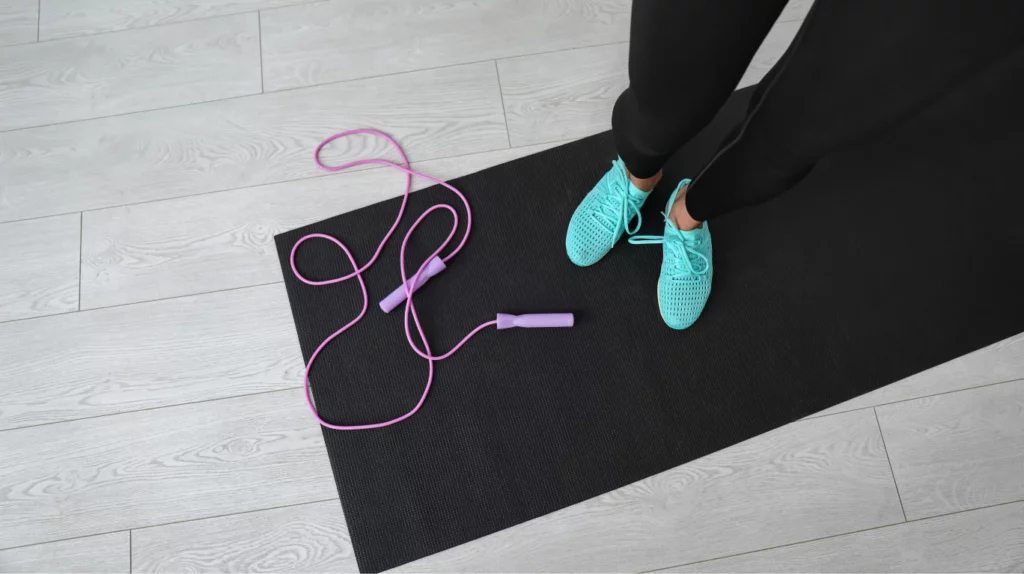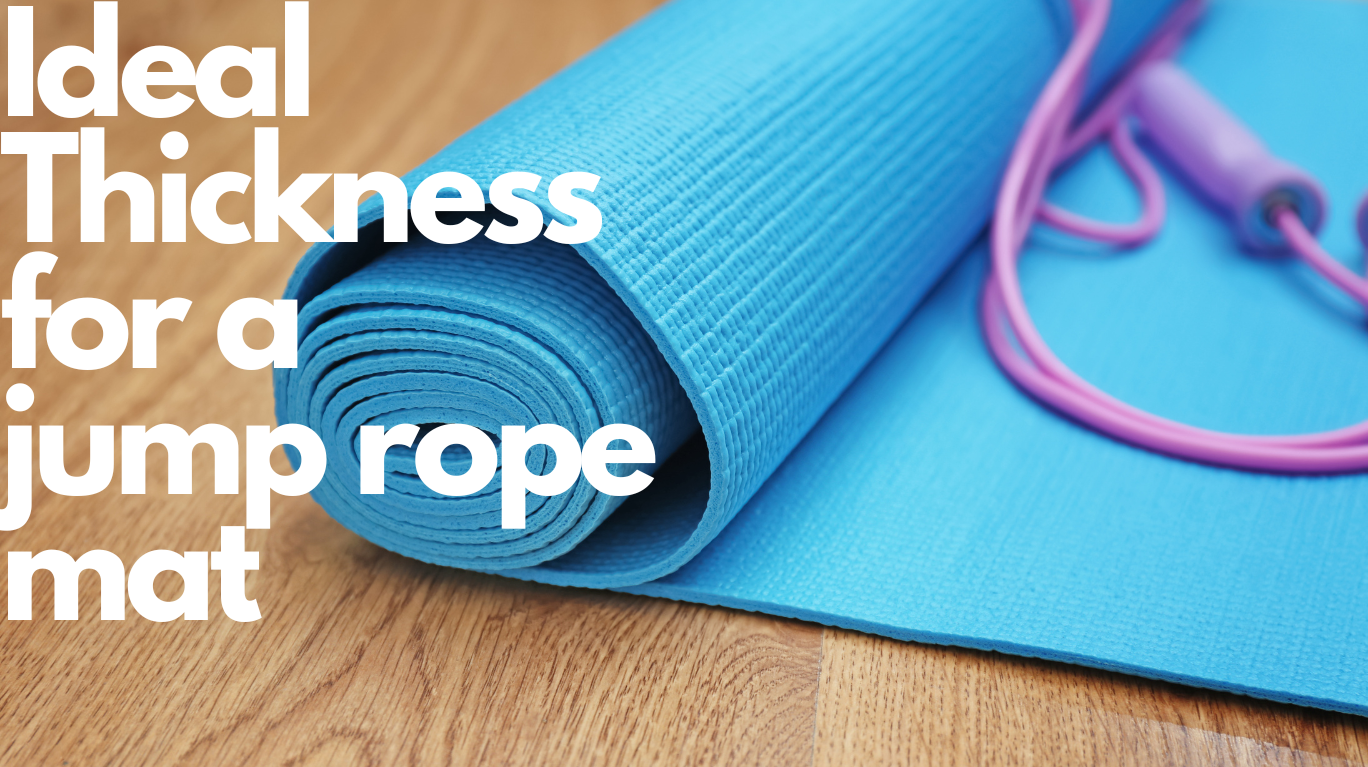Embarking on a jump rope journey promises both excitement and results, but what about the shock to your joints? Not so thrilling. Imagine you are in the rhythm, the rope swishing smoothly until your feet pound on the hard ground and cry out for mercy. That’s where jump rope mat thickness comes into play.
If your mat is too thin, it’s like hopping on hardwood; if it’s too thick, it turns into a moon-bounce and messes up your workout with too much bounce. Striving for the perfect balance? The quest to pinpoint the right thickness for a jump rope mat isn’t a path you tread alone.
Let’s unroll the solution that keeps your joints jubilant without turning your skip into a stumble.
How Thick Should a Jump Rope Mat Be?

Jump rope training is a high-intensity workout that blends the goal of progress with the impact of reality. As many fitness enthusiasts and athletes can testify, the secret to a successful and enduring jump rope routine often lies beneath one’s feet.
Jump rope mats are an essential accessory for anyone who wants to get the most out of their jump rope workouts. The right thickness of the mat can make all the difference in terms of comfort and performance. While it might not seem like much, the thickness of the mat has a big influence on your joints and injury prevention.
At 1/4 inch or 6mm, the ideal thickness strikes a balance between comfort and functionality, providing a foundation for a successful workout routine. In this article, we will delve into the importance of jump rope mat thickness and guide you on how to choose the right thickness for your needs. Let’s explore together and make the most out of your workouts!
The Importance of Jump Rope Mat Thickness
When it comes to jumping rope, the subject of mat thickness is often overlooked. However, it plays a pivotal role in both the efficacy of workouts and the safety of the jumper. Diving into the impact of mat thickness is not just about cushioning. It’s about transforming a good workout into a great one.
A mat that is too slim may offer insufficient protection against constant beating. This can result in jarring shock waves felt not just through the soles, but up through the spinal column. On the flip side, a mat that is too thick may absorb the energy from each bounce. This can distort the motion and increase the chance of ankle rolls.
Optimal mat thickness shields delicate joints from the jarring impacts of gravity. It also facilitates smoother jumps, enhancing the overall jumping experience. This fosters a performance focus on form and endurance, rather than the fear of injury.
Factors Influencing Jump Rope Mat Thickness
The ideal thickness for a jump rope mat depends on several factors. Let’s take a closer look at each of these factors to determine the right thickness for your jump rope routine.
1. Body Weight
Your body weight plays a pivotal role in determining the appropriate mat thickness. It goes without saying that the heavier you are, the thicker the mat needs to be to absorb the impact of each bounce. Generally, a good rule of thumb is to opt for a mat that is 1/4 inch or 6mm thick for every 10 pounds of body weight.
2. Jumping Surface
The surface below the mat also plays a significant role in determining the right thickness. For example, jumping on concrete may need a thicker mat than jumping on a soft surface like a mattress. The harder the surface, the more cushioning your joints need to prevent damage.
3. Jumper’s Experience Level
Experienced jumpers may prefer a thinner mat to provide more feedback. This allows them to make more precise movements during their workouts. On the other hand, beginners may benefit from a thicker mat to reduce the risk of injury. It also allows for a more comfortable jumping experience.
4. History of Joint Issues
If you have a history of joint issues, you may need a thicker mat to provide added protection and support. A plusher surface can help reduce the impact of each bounce and minimize the strain on your joints.
5. Pad Materials
The materials used to make the jump rope mat can also impact its thickness. High-density foams offer superior impact resistance and last longer. While softer materials might compress too quickly, nullifying the added thickness.
Benefits of Choosing the Right Thickness for a Jump Rope Mat
The act of picking a mat with suitable thickness is not merely for comfort. It is an investment in health and performance. Here are the benefits it can provide:
-
Good Cushioning
A mat with the right thickness provides sufficient cushioning to protect your joints. It does so without compromising on performance. You can jump confidently. Focus on your form and endurance without worrying about the impact of each bounce.
-
Injury Prevention
By choosing the right thickness for your jump rope mat, you can reduce the risk of injury. The cushioning absorbs the impact of each bounce, preventing shock waves from reaching your joints and muscles.
-
Impact Absorption
Whether you’re performing basic jumps or advanced tricks, a well-chosen mat thickness absorbs the impact. This lessens the stress on your ankles, knees, and hips. This is especially crucial for high-intensity jump rope sessions.
-
Enhanced Performance
An optimal mat thickness can enhance your performance. It allows you to focus on form and technique without worrying about the impact of each bounce. You can jump with more confidence and intensity, leading to better results and a more enjoyable workout.
-
Jump Rope Life Extension
Finally, the right thickness for your jump rope mat can help extend the life of your rope. A thicker mat can protect the rope from surface damage and ensure it lasts longer between replacements.
Thick vs. Thin: Breaking Down Your Jump Rope Mat Options
Selecting the correct jump rope mat is essential for an optimal workout experience. It’s a balancing act between cushioning and stability. In the thick versus thin debate, a myriad of factors come into play. Understanding the pros and cons of each can guide you to make an informed decision to suit your jump rope routine.
Going Thick
Embracing a thick jump rope mat can be akin to jumping on a cloud, soft, cushioned, and gentle on your joints. The plush surface provides significant shock absorption, which is a good for those with knee or ankle concerns. Each landing is gentler, providing a more comfortable experience. Additionally, the protective barrier between you and the hard floor is more strengthened.
However, there’s a flip side to every coin. An overly thick mat might feel like jogging through sand: it can sap your energy and affect your rhythm. The extra give may also increase the risk of ankle rolls, especially when performing lateral movements or tricks. Moreover, transporting and storing a bulky mat can be a cumbersome chore.
Another vital aspect to ponder is the practicality of balancing comfort with performance. A dense mat is kind to your joints, ensuring their protection. It shouldn’t, however, hinder your ability to perform fast-paced skips or double-unders. The art of compromise lies herein. Opt for a mat that’s enough padded, enabling nimble footwork and speedy movements without sinking too deep into the surface.
Going Thin
Conversely, a thin mat might be the unsung hero for seasoned rope skippers. Less cushion means increased stability and improved feedback from the floor. This is crucial for refining advanced techniques or maintaining a brisk rhythm, which is vital for progress. The firmness of a thin mat can facilitate the precision required for complex jump rope sequences.
Nonetheless, with thinness comes a greater responsibility to remain vigilant about the risks involved. A mat that’s too thin on padding can be unforgiving on a bare surface, especially for longer sessions. The shock from repetitive impacts may escalate, burdening your lower extremities and spine. The outcome? Potential injuries like shin splints or plantar fasciitis that could sideline your training.
Real-world consequences of scrimping on mat thickness are clear. Without adequate protection, the repetitive impact force of each landing can build up and cause wear and strain on joints and muscles. It may not happen overnight, but the constant impact can eventually wear you down over time. This can lead to chronic illnesses or discomforts, preventing you from experiencing the joy of jumping.
Conclusion
In conclusion, when deciding on jump rope mat thickness, consider your routine and joint health. The right thickness for a jump rope mat strikes a balance between cushioning and stability. Too thick, and you may compromise your rhythm; too thin, and you risk injury. To determine how thick should a jump rope mat be for you, weigh the comfort against the practicality and potential risks. Always remember that the best mat supports your performance and safeguards your well-being.
Common Queries
What is the ideal thickness for a jump rope mat?
The ideal thickness for a jump rope mat is 1/4 inch. This allows for optimal rope movement and prevention of the rope from digging into the mat.
What type of mat is suitable for jumping rope?
A flat, sturdy, and durable mat with a smooth surface is suitable for jumping rope.
Are jump rope mats a good investment?
Yes, a good quality jump rope mat is a worthwhile investment as it provides a comfortable and safe surface for jumping rope. It reduces the risk of injury and can help improve your performance.
Which is better for jumping rope, a thin or thick rope?
A thicker rope may provide more cushioning and support. However, a thin rope may be easier to handle and more suitable for beginners.
Do jump rope mats help reduce noise?
Jump rope mats can help reduce noise to some extent, but the primary function of a mat is to provide a comfortable and safe surface for jumping rope.

